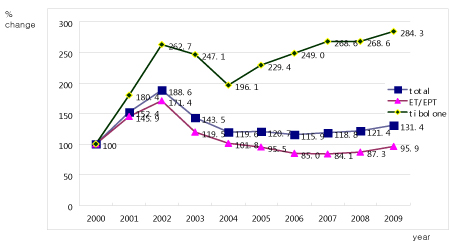Korean J Obstet Gynecol.
2010 Dec;53(12):1110-1117. 10.5468/kjog.2010.53.12.1110.
The change of hormone therapy in postmenopausal women in Korea before and after women's health initiative study: 2000~2009
- Affiliations
-
- 1Department of Obstetrics and Gynecology, Chung-Ang University College of Medicine, Seoul, Korea. hmpark@hananet.net
- KMID: 2037512
- DOI: http://doi.org/10.5468/kjog.2010.53.12.1110
Abstract
OBJECTIVE
This study aims to survey the change of comsumption of hormone therapy (HT) before and after publication of Women's Health Initiative Study(WHI) result in Korea from 2000 to 2009.
METHODS
Data from Intercontinental Marketing Services were used to analyze and ten years of hormone consumption from 2000 to 2009 was expressed in terms of hormone sales amount (Korean won, KRW, 1 dollar=1,100 won). Total hormone consisted of Estrogen (ET), Estrogen/Progestogen (EPT), and Tibolone. To identify changes in total hormone consumption, the cumulative growth rate was based on the sales in 2002.
RESULTS
After publication of WHI result in 2002, HT consumption had been continuously decreased by 39% from 51.1 billion (bn) KRW in 2002 to 31.4 bn KRW in 2006. From 2007 to 2009, HT consumption has been slightly increased to 3.56 bn KRW. The decreased consumption of HT is mainly due to decrease of ET/EPT comsumption by 49%. Tibolone consumption was decreased by 25% during next 2years after WHI publication, but thereafter gradually increased over pre-WHI publication level in 2009. The proportion of consumption of low dosage regimen was markedly increased from 3.5% in 2002 to 41.8% in 2009.
CONCLUSION
The total hormone consumption was markedly decreased after WHI. Low dosage regimen consumption was increased, comprising 3.5~41.8% of total EPT consumption. Tibolone consumption was transiently decreased during 2 years after WHI publication, but thereafter increased gradually and reached over the level of pre-WHI publication in 2009. We expect that low-dosage regimen of HT and tibolone will be more widely used. An individual-based treatment approach is essential in assessing the appropriateness of initiating hormone replacement therapy.
Keyword
MeSH Terms
Figure
Cited by 1 articles
-
Perceptions of Postmenopausal Symptoms and Treatment Options among Middle-Aged Korean Women
Min Kyoung Kim, Seok Kyo Seo, Hee Dong Chae, Kyung Joo Hwang, Tak Kim, Byung-Koo Yoon, Byung Seok Lee
Yonsei Med J. 2017;58(3):533-539. doi: 10.3349/ymj.2017.58.3.533.
Reference
-
1. Rossouw JE, Anderson GL, Prentice RL, LaCroix AZ, Kooperberg C, Stefanick ML, et al. Risks and benefits of estrogen plus progestin in healthy postmenopausal women: principal results From the Women's Health Initiative randomized controlled trial. JAMA. 2002. 288:321–333.2. Cauley JA, Robbins J, Chen Z, Cummings SR, Jackson RD, LaCroix AZ, et al. Effects of estrogen plus progestin on risk of fracture and bone mineral density: the Women's Health Initiative randomized trial. JAMA. 2003. 290:1729–1738.3. Hersh AL, Stefanick ML, Stafford RS. National use of postmenopausal hormone therapy: annual trends and response to recent evidence. JAMA. 2004. 291:47–53.4. Nelson HD. Assessing benefits and harms of hormone replacement therapy: clinical applications. JAMA. 2002. 288:882–884.5. Solomon CG, Dluhy RG. Rethinking postmenopausal hormone therapy. N Engl J Med. 2003. 348:579–580.6. Pines A, Sturdee DW, Birkhauser MH, Schneider HP, Gambacciani M, Panay N. IMS updated recommendations on postmenopausal hormone therapy. Climacteric. 2007. 10:181–194.7. Rossouw JE, Prentice RL, Manson JE, Wu L, Barad D, Barnabei VM, et al. Postmenopausal hormone therapy and risk of cardiovascular disease by age and years since menopause. JAMA. 2007. 297:1465–1477.8. Korea National Statistics Office. Statistics for the elderly. 2007. Daejeon: Korea National Statistics Office.9. Korea National Statistics Office. Statistics for the future population. 2006. Daejeon: Korea National Statistics Office.10. Korea National Statistics Office. International Marketing Service. The statistics of medicine. 2009. Daejeon: Korea National Statistics Office.11. Panay N, Fenton A. HRT: does the dose matter? Climacteric. 2008. 11:177–178.12. Birkhauser MH, Reinecke I. Current trends in hormone replacement therapy: perceptions and usage. Climacteric. 2008. 11:192–200.13. Panay N, Ylikorkala O, Archer DF, Gut R, Lang E. Ultra-low-dose estradiol and norethisterone acetate: effective menopausal symptom relief. Climacteric. 2007. 10:120–131.14. Smith CL, O'Malley BW. Coregulator function: a key to understanding tissue specificity of selective receptor modulators. Endocr Rev. 2004. 25:45–71.15. Kenemans P, Speroff L. Tibolone: clinical recommendations and practical guidelines. A report of the International Tibolone Consensus Group. Maturitas. 2005. 51:21–28.16. Kenemans P, Bundred NJ, Foidart JM, Kubista E, von Schoultz B, Sismondi P, et al. Safety and efficacy of tibolone in breast-cancer patients with vasomotor symptoms: a double-blind, randomised, non-inferiority trial. Lancet Oncol. 2009. 10:135–146.17. Cummings SR, Ettinger B, Delmas PD, Kenemans P, Stathopoulos V, Verweij P, et al. The effects of tibolone in older postmenopausal women. N Engl J Med. 2008. 359:697–708.18. Lundstrom E, Christow A, Kersemaekers W, Svane G, Azavedo E, Soderqvist G, et al. Effects of tibolone and continuous combined hormone replacement therapy on mammographic breast density. Am J Obstet Gynecol. 2002. 186:717–722.19. Archer DF, Hendrix S, Gallagher JC, Rymer J, Skouby S, Ferenczy A, et al. Endometrial effects of tibolone. J Clin Endocrinol Metab. 2007. 92:911–918.20. Huang KE, Baber R. Updated clinical recommendations for the use of tibolone in Asian women. Climacteric. 2010. 13:317–327.
- Full Text Links
- Actions
-
Cited
- CITED
-
- Close
- Share
- Similar articles
-
- Women's Health Initiative Study and Current Recommendation of Hormone Replacement Therapy
- Hormone Therapy in Postmenopausal Women
- Breast Parenchymal Change on Mammography Following Postmenopausal Hormone Replacement Therapy
- Change in Medication of Osteoporosis in a University Hospital after Women's Health Initiative (WHI) Clinical Trial
- Mortality Associated with Hormone Replacement Therapy in Postmenopausal Women




